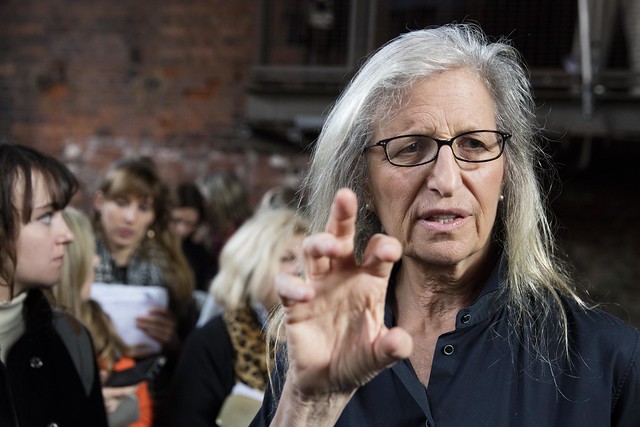
Annie Leibovitz WOMEN: New Portraits exhibition commissioned by UBS.Wapping Hydraulic Power Station. 16 January – 7 February © Martin Ruetschi
Maddie Salters heads to the Wapping Hydraulic Power Station for a look at WOMEN: New Portraits by Annie Leibovitz.
The groaning of the spindly stairs underfoot leads to a large floor plan of elderly red brick faces, peeling white paint, and unkempt hydraulic machinery in situ. This aged London power plant in the East End has become the spot du jour for artist exhibitions. A serious and transformative space, it lends a sense of history and gravity to the photographs that hang there today, lit by tall windows pouring in muted daylight – a London commodity. It seems fitting, then, that the current exhibition is a combination of the past and the present: WOMEN: New Portraits, by seminal photographer Annie Leibovitz.
Annie, in a career that spans The Rolling Stones to Vogue, has managed to straddle very different walks of life with an easy familiarity: she’s at home in amped-up rock-n-roller settings, is trusted by the most elegant fashionistas, and perhaps most importantly, knows about hectic day-to-day life as a single mom raising three daughters. It’s her diversity of spirit and her ability to metamorphose herself that’s allowed this collection to bloom. WOMEN combines works from her 1999 project of the same name and subject matter, with the photos she’s taken since. Aptly named, it captures a variety of women in there element, in a variety of portraits: from the old-school, a set of 10 photos where Cindy Sherman dodges the camera, desperate not to show her face during her own photo session, to the new-school, where the Kardashian-West girls are mid-selfie, a photo of a photo.
WOMEN aims to look at the way the roles and notion of womanhood have changed over time. After a shoot with Caitlyn Jenner, Annie describes, “It was like creating a new person, around the idea of what a woman is… what is, who is this new person?” The concept first fascinated her decades past, after shooting Vegas showgirls inside and outside of their makeup. “They were so normal looking [out of costume]… my [showgirl] photos represented how women dressed up to be women.” But what happens when you dress the concept of womanhood down?
On one wall, images from her past collection flash, raw, mostly in black and white. On another wall, the Queen of England looks just a little mischievous, and nearby is Adele, who looks fantastically bored as she keys at her piano. On the other end of a spectrum, an unrecognisable woman in a sparse room protects her child from her phantom fears. A board runs the length of the room, photos stuck down by pushpins, like the scene of a crime. There are a few names stuck up on the board, portraits still to come – “Malala”, “Serena + Venus”– as the project is ongoing. In fact, Annie doubts she’ll ever stop. “[Womanhood] is a subject too big, too broad… it’s like going out and photographing the ocean.”
What really makes the collection for me is Annie’s sense of space. She intentionally tried to “shoot in places with no identity”, so that her subjects could full each frame with their own energy, story, personality. She focused on that moreso with the new collection, where she says she learned today’s women have a better “sense of who they are”, with no need for adornment. It comes across. The collection is almost fragmented, eclectic: strong composition in one piece, where a woman in a flowing gown faces the wind with a brave, bracing pose, but intentionally weaker in another, where colours look muted and gray, and someone is wearing casual clothing, going about a mundane day. A powerful look in the eye of one woman in her portrait, a lost sort of expression plaguing another. Each photo has just a little bit of disconnect from the one before it, but when viewed together, each stand alone presence seems to give these women the quality of being real, of being present, of being there in the space with you. These narratives are part of our modern world, despite the kimono fabrics and clay beads spotted here and there, not a part of London’s daily traditions – but still hobnobbing with the queen.
The exhibit opened to public this weekend at the Wapping Hydraulic Power Station, and will be in town until February 7th. Then, it will travel across nine other international cities, remaining free to the public in each touchdown destination, to provide access to all who want it. It will in Zurich, where by that time it should contain an additional fifty portraits. It was commissioned by UBS, to show a stronger commitment between the Swiss Bank to their goals to gender equality and the arts, and Annie collaborated with Gloria Steinem on the project, whom she describes as both anchor and compass.
The exhibit pushes not only our ideas about what a woman is and what she can be within a private and professional space, it toys with the fine line between tasteful and vulgar in depicting woman’s naked form, and turns our ideas about beauty inside-out by rejecting norms, and embracing each stage in a woman’s life– from girlhood, to the many lines and spots of old age. Annie says it’s more installation art, than showpiece. “This is the first time that I’ve done work and just thrown it up. …One of the great things about being an older person is that I am very aware of the scope of the work and the historical sense of it. It’s bigger than me.”
WOMEN: New Portraits is on display at the Wapping Hydraulic Power Station, Wapping Wall, E1W 3SL until 7 Februray 2016. UBS is the Exclusive Commissioning Partner. Find out more at ubs.com/annieleibovitz.





















